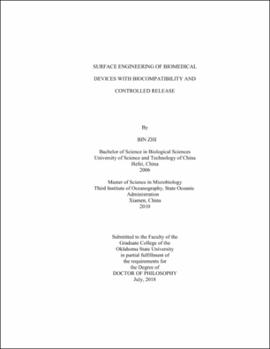| dc.contributor.advisor | Mao, Yu | |
| dc.contributor.author | Zhi, Bin | |
| dc.date.accessioned | 2023-04-26T16:20:27Z | |
| dc.date.available | 2023-04-26T16:20:27Z | |
| dc.date.issued | 2018-12 | |
| dc.identifier.uri | https://hdl.handle.net/11244/337475 | |
| dc.description.abstract | Modern medicine practice requires advanced medical devices with better biocompatibility, longer durability, and more complexity. Challenges arise for traditional techniques to apply a conformal modification on the complicate surfaces of modern implants in micro-scale to achieve better performance. Tailoring implant surface with hydrophilic coating was proven as an efficient strategy towards better biocompatibility. Precise modification of surface chemistry to accommodate the biological environment of the implants using initial chemical vapor deposition (iCVD) produced conformal nanocoating with excellent biocompatibility. In this study, highly crosslinked nanocoating was deposited on stainless steel surface and grafted with mixed charged polyionic using a one-pot three-step iCVD. Coated surface showed enhanced wettability with no adsorption of BSA after a seven-day incubation. Significant reduction of laminin adsorption and microglia attachment was observed, indicating excellent resistance against foreign body reaction for neural microelectrodes application. Secondly, with high density grafting, dual-charged antifouling grafting with a grafting thickness under 10 nm was synthesized with higher hydrophilicity. No BSA adhesion was shown on grafted surface from pH 7 to pH 9 and at body temperature, indicating significant enhancement of biocompatibility for implant applications that can withstand high pH. Thirdly, engineering of controlled release greatly improves the implant performance and avoids side effects. Charged nanocoating showed low permeability for opposite charged medication, making an effective diffusion barrier for controlled release of the medicine. Polyionic nanocoating provided three months of stable release, significantly suppressed smooth muscle cell growth. Adhesion of platelet on the coated surface was significantly reduced due to enhanced blood compatibility, indicating potential application in tissue reconstruction. Fourthly, further study into release control mechanism made it possible to synthesize nanocoatings with stable controlled release for non-charged medicine. Ultrathin simvastatin incorporated hydrogel with an 11-week stable release was synthesized using iCVD method. Biocompatible hydrogel coated sample provided controlled release of medicine in effective dosage without burst release. Coated sample significantly promoted preosteoblasts activity in vitro. In summary, application of vapor deposition of ultrathin coatings from commercially available reagents on different medical devices effectively improved substrate biocompatibility and drug release functionality, showing great potential in future implant application. | |
| dc.format | application/pdf | |
| dc.language | en_US | |
| dc.rights | Copyright is held by the author who has granted the Oklahoma State University Library the non-exclusive right to share this material in its institutional repository. Contact Digital Library Services at lib-dls@okstate.edu or 405-744-9161 for the permission policy on the use, reproduction or distribution of this material. | |
| dc.title | Surface engineering of biomedical devices with biocompatibility and controlled release | |
| dc.contributor.committeeMember | Atiyeh, Hasan | |
| dc.contributor.committeeMember | Dunford, Nurhan | |
| dc.contributor.committeeMember | Madihally, Sundar | |
| osu.filename | Zhi_okstate_0664D_15943.pdf | |
| osu.accesstype | Open Access | |
| dc.type.genre | Dissertation | |
| dc.type.material | Text | |
| dc.subject.keywords | antifouling | |
| dc.subject.keywords | biocompatibility | |
| dc.subject.keywords | controlled release | |
| dc.subject.keywords | iCVD | |
| dc.subject.keywords | implant | |
| dc.subject.keywords | surface engineering | |
| thesis.degree.discipline | Biosystems Engineering | |
| thesis.degree.grantor | Oklahoma State University | |
